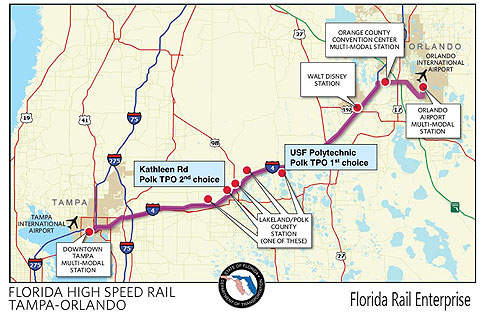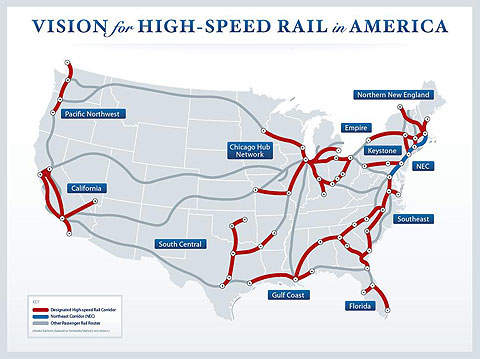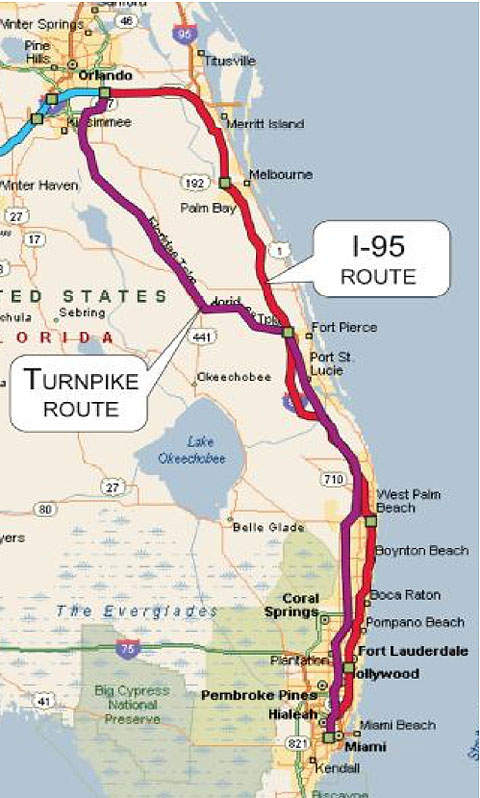The Florida High-Speed Rail (HSR) system will be the first-of-its-kind passenger rail network in the US state of Florida. The project was granted $1.25bn from the American Recovery and Reinvestment Act (ARRA) in January 2010 as part of an $8bn fund made available for HSR projects across the US. California received $2.25bn in funding, which will be used for a planned rail link between Los Angeles and San Francisco.
A total of 31 states will receive funding as part of the High-Speed Intercity Passenger Rail (HSIPR) programme. The federal government will also award $1bn a year for five years as down payment on the programme. The ARRA funds will be used for laying and developing 13 high-speed railway corridors in different US states. The large-scale corridors will also form the basis of future high-speed intercity passenger rail services in the US.
The Florida HSR system will connect the Tampa Bay area, Orlando, Miami, and communities in central and south Florida. The first phase of the HSR will connect the Tampa and Orlando metropolitan areas including major tourist destinations in Florida.
The traffic between the area is mainly dependant on road transportation, particularly Interstate 4. The Tampa-Orlando rail line is estimated to serve more than 5,400 passengers a day.
The Tampa-Orlando corridor project is estimated to cost $2.6bn. While $1.25bn has been granted under the ARRA, the remaining $1.35bn is expected to be funded from other federal resources (80%) and the State of Florida (20%). The Florida Department of Transportation will also form a public-private-partnership to execute the HSR system. The project is expected to create thousands of jobs in Florida and also support economic activity in the state.
Florida high-speed rail project
Phase 1 of the project will involve the construction of the 84-mile HSR line corridor between Tampa and Orlando. The corridor will allow trains to run at 168mp/h (270km/h) and will reduce the time taken to travel between the cities from 90min by car to less than one hour. The route will operate five train sets with a capacity of between 200 and 250 passengers each, making 16 round trips every day. Work on Phase 1 is expected to start in early 2011 and will be completed in late 2014.
The route will be extended from Orlando to Miami in Phase 2. The line will be connected through a coastal or inland HSR route. Completion of the 240-mile segment between Orlando and Miami will enable trains to run at 186mp/h (299km/h). The line will reduce the travel time by about two hours and will make 20 round trips a day. Phase 2 will be executed without any funding from the ARRA. Planning is in progress and the line is expected to be operational in late 2017.
Florida rail transport background
A transit corridor study was conducted during the 1970s. In 1991 the Florida Department of Transportation (FDOT) initiated studies to implement the HSR system. A consortium of Odebrecht, Fluor Daniel, GEC Alsthom and Bombardier, called Florida Overland Express (Fox), was selected in 1996 for engineering and the implementation of the project. In 1999, however, state funding for the Fox project was terminated because of a risk associated with projected passenger revenues.
In November 2000 Floridian voters enacted an amendment to the State’s Constitution that mandated the construction of a high-speed transportation system. The Florida High-Speed Rail Authority (FHSRA) was formed in 2001 to implement the HSR system.
The FHSRA proposed a bullet-train line between downtown Tampa and Orlando International Airport. The Final Environmental Impact Statement (FEIS) for Phase 1 of the project was prepared in 2005 and re-evaluated in 2009. It suggested some changes to the earlier FEIS to meet the National Environmental Policy Act requirements.
The design phase will involve the coordination of the FRA, FDOT and the Federal Highway Administration for the development of a safety plan in accordance with FRA standards.
The environmental impact studies for the Phase 2, Orlando to Miami corridor began in 2010 and are expected to be completed in two years.
The project is being implemented by Florida Rail Enterprise, which was established on 16 December 2009 under the authority of the FDOT. It is responsible for the planning, construction, maintenance and operation of the HSR system. In March 2010, Florida Rail Enterprise appointed a joint partnership of HNTB and Wilbur Smith Associates as the programme manager for the HSR link between Tampa Bay and Orlando.
Florida high-speed rail infrastructure
The HSR trains will be operated in a confined barrier-protected corridor and on dedicated lines without grade-crossings. The corridors are expected to use steel wheel electric system technology with a catenary wire overhead. The stations will be built according to LEED certification. The scope of the work will also include the construction of track, electrification systems, signalling and communications and the provision of rolling stock.
A multi-modal station will be constructed at Tampa. Other stations will include an intermediate station at the Lakeland/Polk County, a station at Walt Disney World Resort, a multimodal station at Orange County Convention Centre, and a multi-modal station at Orlando International Airport, which is likely to be the system’s hub station. All stations will be connected with other transit systems such as bus and taxi services.
Line routes
The high-speed rail lines are planned to be constructed alongside Florida’s existing highway network. Phase 1 line of the system will start in downtown Tampa at a planned intermodal transportation centre and end at Orlando International Airport. Phase 2 is being planned to run alongside Florida’s Turnpike or the I-95.





